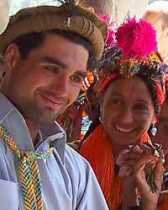
The Two Arrows
When the Kalasha people first entered Rumbur Valley, their greatest shaman, Naga Dehár, stood at the pass with his back to Afghanistan. He fired two arrows, one red and one black. Where the black arrow landed, they built the altar to Sájigor, still the most sacred place in the Kalasha valleys.
Where the red arrow landed, they built the first bashali—the women's moon-house (Maggi 47).
It's as if one were to discover an ancient Celtic tribe living up in the mountains, still practicing their old religion.
The Kalasha are a people some 4000-strong who live in three remote valleys in the Hindu Kush mountains of what is now Pakistan. They are known far and wide for their wine-drinking, for the beauty (and social freedom) of their women, and for their proudly polytheist religion, which in many ways more closely resembles pre-Hindu Vedic religion than anything else.
With their pantheon of gods and goddesses, animal sacrifices, and sacred dances, the Kalasha are probably as close as we will ever come to the Indo-European ancestors.
The more that I learn more about the Kalasha, the more struck I am by just how familiar they seem.





















